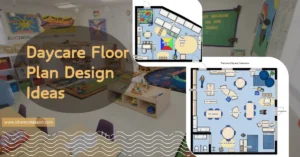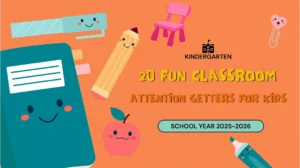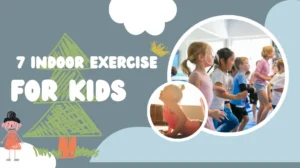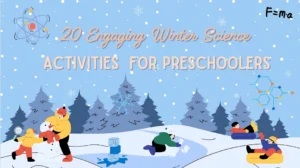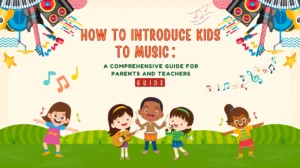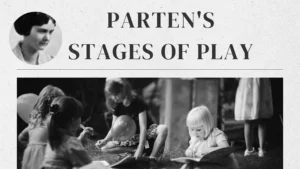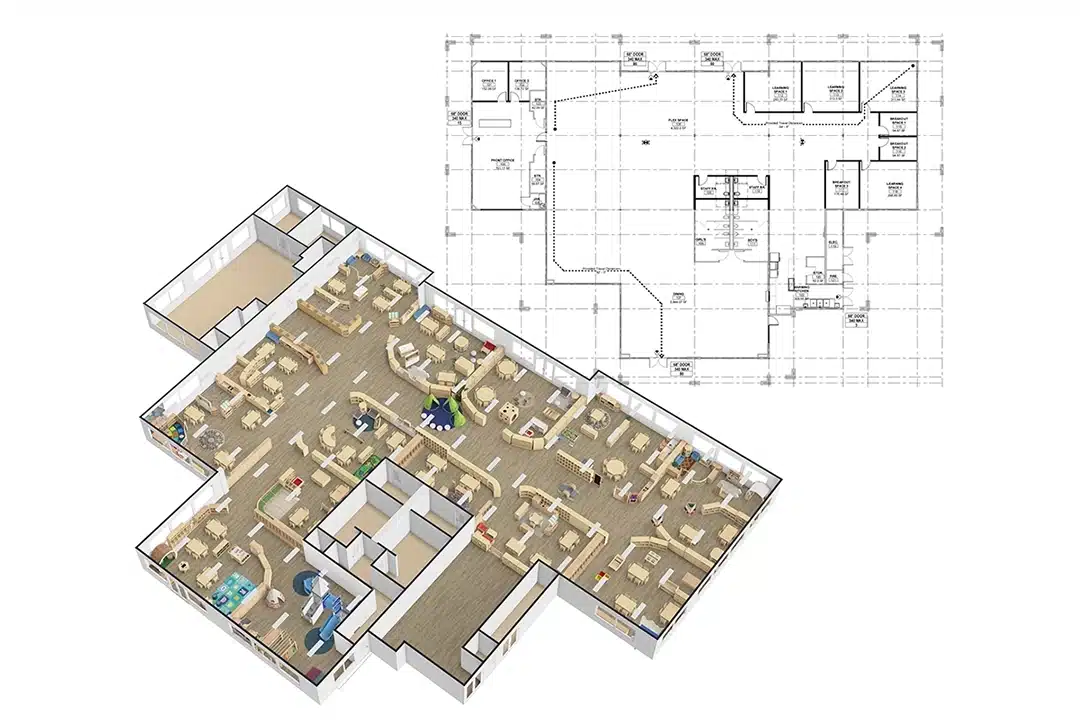Are you a preschool teacher or parent looking to create a magical and immersive learning environment for little ones? Look no further! This guide will help you choose the perfect preschool classroom themes that spark curiosity, foster creativity, and enhance early childhood development.
Preschool classroom themes can greatly impact the effectiveness of instruction and the overall learning experience for students. Ideal themes should be visually appealing to children, promote educational concepts, and accommodate a variety of activities and lessons. Themes such as “Under the Sea,” “Space Exploration,” and “Around the World” are perfect for inspiring curiosity and encouraging learning through exploration and play.
The right themes can transform an ordinary classroom into a captivating wonderland. But with so many options available, how do you choose?
All are met in this post as we guide you through choosing a preschool classroom themes that meets your teaching goals, engages young minds, and creates a nurturing environment. We’ll explore popular themes, discuss how to incorporate them effectively and offer tips for bringing your chosen themes to life through decorations, activities, and lesson plans.
What Is Preschool Classroom Themes?
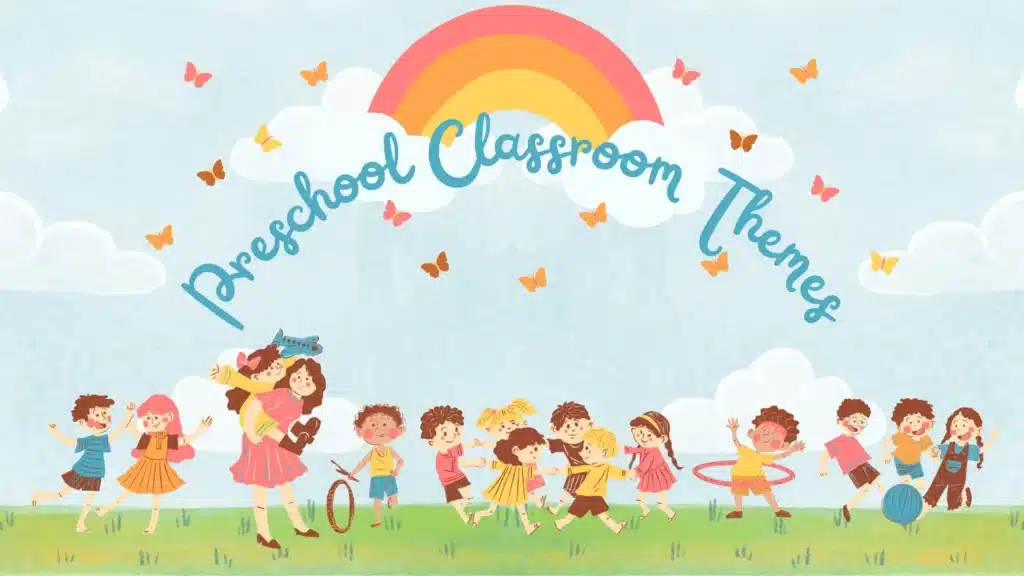
Preschool classroom themes are a unifying concept or idea that sets the tone for the learning environment. It involves creating a cohesive and immersive experience that engages children’s senses, sparks their curiosity, and promotes meaningful learning.
Preschool classroom themes are more than just decoration. It provides a framework for organizing activities, materials, and experiences that align with the chosen concept. It creates a visually appealing and stimulating preschool classroom environment that supports children’s development in all areas.
Themes can be based on topics such as nature, animals, transportation, or abstract concepts like colors or shapes. The key is to choose a theme that resonates with teachers and students to create an environment where imagination flourishes and learning thrives.
What Are Thematic Units?
Thematic units are comprehensive learning frameworks centered around a specific theme or topic. These classroom themes provide an integrated approach to education, allowing educators to link various subjects—such as math, science, and art—under one overarching concept. This interconnected learning helps preschoolers grasp complex ideas more effectively, making it an ideal approach for preschool classroom themes.
To create thematic units, start with a central theme and brainstorm activities across different subjects. This method encourages the use of classroom theme ideas that span a variety of educational areas. Children learn best when they see how different concepts interrelate, making classroom theme decoration ideas and activities part of the learning environment.
Incorporating thematic units into your curriculum can also streamline planning. Instead of creating separate lesson plans for each subject, you can develop integrated lessons that are easier to manage, especially when using classroom decorating themes that align with your chosen topics. This saves time and creates a more dynamic learning environment where the classroom theme decor enhances learning. For example, simple, cute classroom theme ideas like a pirate theme or space classroom theme can be used across all subjects.
Assessments in thematic units can also take various forms. Instead of traditional testing, consider project-based assessments where children can demonstrate their understanding through creative projects, presentations, or group activities. This allows for a more authentic evaluation of their learning while reinforcing the preschool classroom themes decor. These assessments can be based on the theme of the classroom, such as a farm-themed classroom or a winter wonderland classroom where students showcase their grasp of the subject through theme-based projects. This type of approach provides opportunities for fun classroom themes to become more than just decor but an active part of learning.
Benefits of Decorating a Preschool Classroom Themes
Having a well-designed preschool classroom themes has many benefits for both teachers and students. Let’s explore some of the advantages:
1. Increased Engagement:
A great preschool classroom themes captures children’s attention and encourages them to participate in learning activities actively. They are more likely to participate and retain information when the environment reflects their interests and stimulates their curiosity.
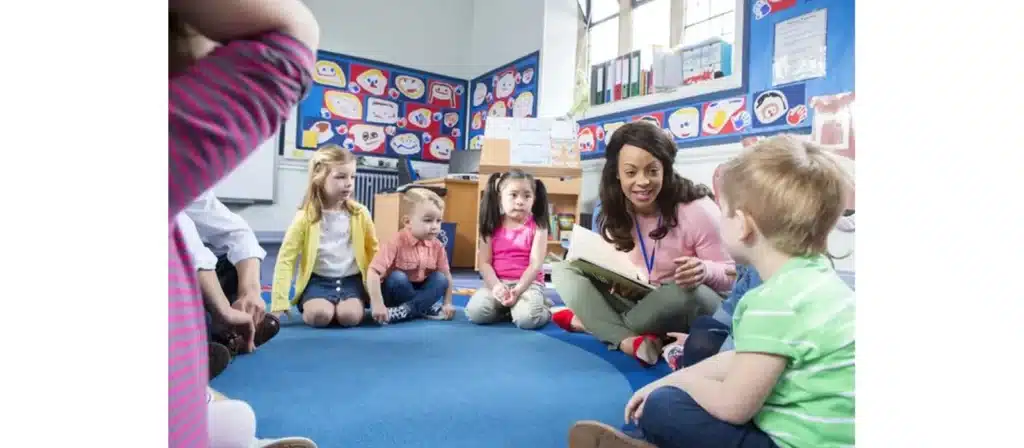
2. Enhanced Learning Experience:
Decorative themes create a cohesive and immersive learning experience for children. It helps them connect different concepts, facilitates cross-curricular learning, and promotes a deeper understanding of the topic.
3. Positive Emotional Impact:
A visually appealing and stimulating environment can positively impact children’s emotional well-being. It creates a sense of belonging, comfort, and security, enhancing their learning experience.
4. Foster a Sense of Community:
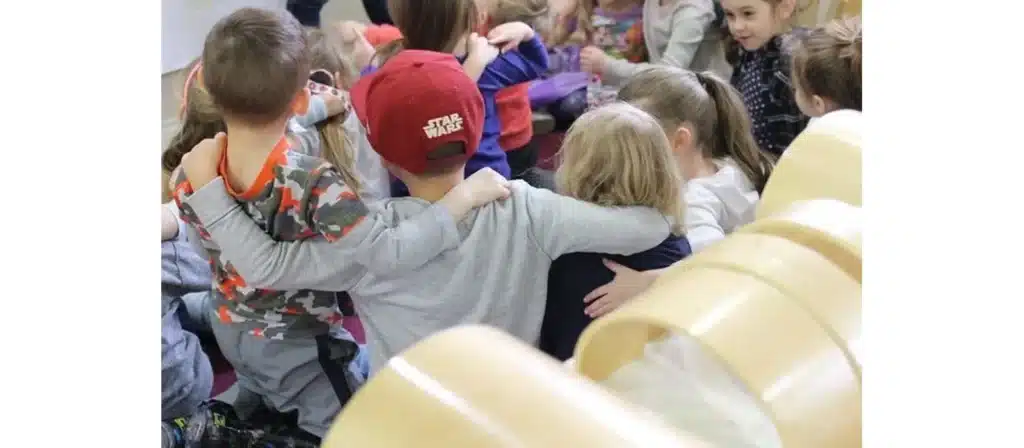
Common themes can help create a cohesive classroom community where students work together to achieve common learning goals.
By designing a preschool room themes, you can create an environment that supports children’s development, inspires a love of learning, and exposes children to a variety of activities that fit different learning styles.
Preschool Classroom Themes Considerations
Several factors come into play when deciding on a preschool classroom themes. These considerations ensure that the chosen themes appeal to the aesthetic senses and enrich the educational experience.
- Relevance to Educational Goals:
The primary consideration should always be the consistency of the themes with the educational objectives. Themes such as “Space Exploration” or “Under the Sea” offer plenty of opportunities to introduce scientific concepts, while “Around the World” fosters cultural awareness and diversity. - Engage with Students: Discuss their favorite topics and interests. This can provide insights into what excites them most.
- Age Appropriateness:
The classroom themes must resonate with the preschool age group. It should be simple enough to understand but interesting enough to stimulate curiosity. Overly complex themes may confuse younger children, while overly simple themes may not appeal to older preschoolers. - Adaptability:
Preschool classroom themes should be adaptable to different subjects, from literacy and numeracy to art and science. This flexibility allows teachers to create a cohesive learning experience that integrates the themes into all curriculum areas. - Safety and accessibility:
Themes should be implemented in a way that is safe and accessible to all students. Decorations and activities must be age-appropriate, safe, and accessible to preschoolers. - Availability of resources:
Consider the availability of resources and materials related to your chosen themes. Make sure you have access to books, props, art supplies, and other resources that effectively support your themes.
By considering these factors, you can make informed decisions that meet your instructional goals and create an engaging learning environment for your students.
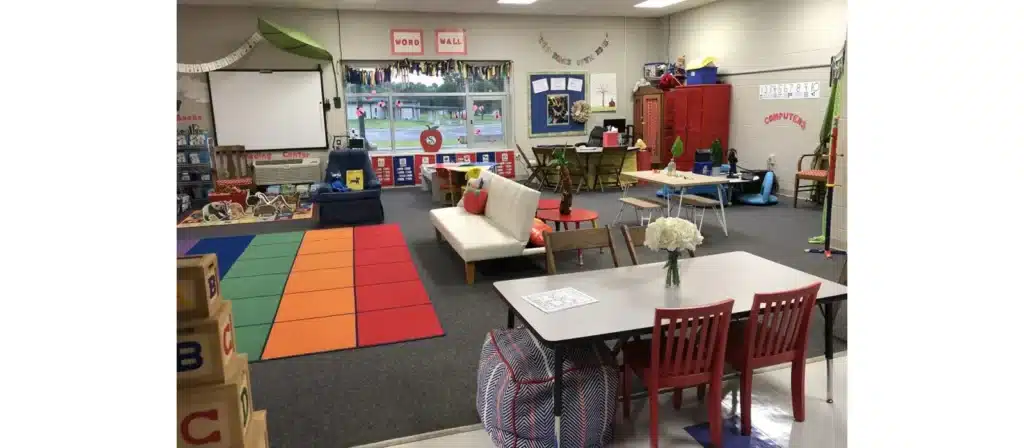
How to Create a Preschool Classroom Themes?
Creating a Preschool classroom themes involves thoughtful planning and creativity. A well-executed theme can transform your classroom into an inviting space that promotes learning. Begin by gathering inspiration and deciding on the core elements of your theme, including colors, decorations, and activities.
Follow these steps to create your classroom theme effectively:
- Gather Inspiration: Explore sources like Pinterest to collect ideas that resonate with your educational philosophy.
- Outline Core Elements: Decide on key colors, decorations, and learning activities that align with your theme.
- Set a Budget: Plan your expenses, prioritizing key decorations and materials for maximum impact.
- Organize What You Already Have: Take stock of existing materials and decorations that can be repurposed for your theme.
- Make a Shopping List: Identify additional items needed to complete your theme and list them for easy shopping.
- Decorate Your Space: Once you have everything, decorate your classroom to immerse students in the theme.
- Implement DIY Projects: Consider creating decorations with your students to enhance their engagement and creativity.
- Maintain Balance: Ensure the theme enhances the learning environment without cluttering the space, promoting focus and organization.
Popular Preschool Classroom Themes
Preschool classroom themes do far more than decorate a space. A well-chosen theme can spark children’s curiosity, provide context for early learning, and create a comforting, cohesive environment. Whether you’re setting up a traditional classroom or an open-ended Montessori/Reggio-inspired environment, a consistent theme helps shape the daily rhythm and child-led discovery that educators aim for.
In this section, we will explore a selection of popular preschool classroom themes that are commonly used across kindergartens, early childhood centers, and international schools. Each of these themes carries developmental, emotional, and sensory value. Some are seasonal, some are cultural, and others are just plain fun — but all support exploration and early learning.
1. All About My Preschool Classroom Themes
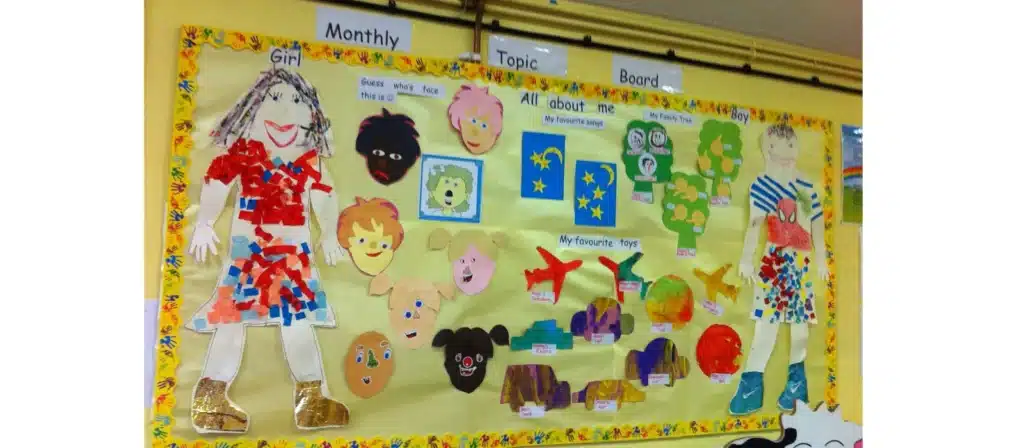
This is often the first theme of the school year and a foundation for everything that follows. It’s designed to help children feel comfortable in their environment by getting to know the classroom space, the daily schedule, and their fellow classmates. This theme includes interactive name displays, family photo walls, and classroom rules crafted through group discussion.
Key learning areas:
- Self-identity and emotional expression
- Name recognition and literacy foundations
- Introduction to classroom routines
- Social bonding through shared storytelling and “all about me” crafts
Extended activities:
- Create personal cubby labels with children’s photos and names
- Use mirrors in dramatic play to promote self-awareness
- Invite families to send in family photos for a classroom “My People” wall
2. Bugs and Insects Preschool Classroom Themes
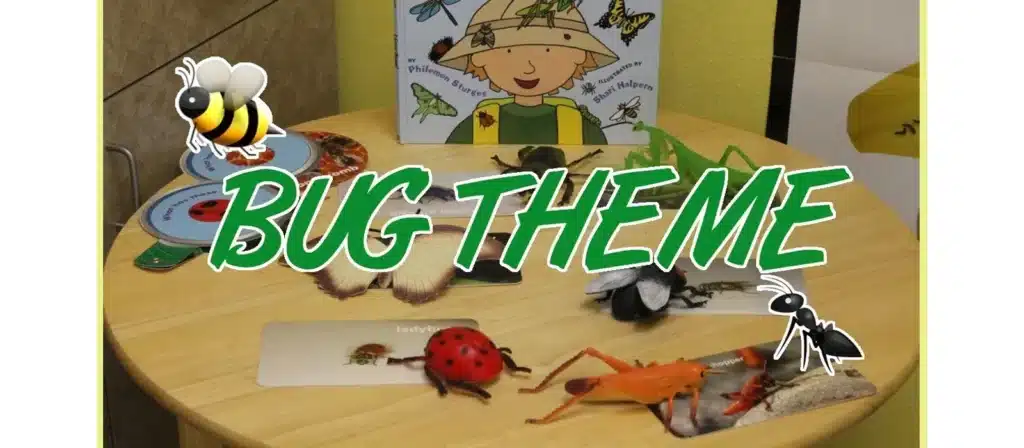
The Bugs and Insects theme introduces children to one of the most engaging parts of nature: the world of tiny, crawling creatures. Through close observation, storybooks, songs, and science stations, children explore the diversity of insect life while developing scientific thinking and empathy for living things.
The classroom may include bug magnifiers, insect sorting trays, and lifecycle posters. Real-world exploration—such as nature walks and bug hunts—helps children apply what they’ve learned in the classroom to their surrounding environment. Vocabulary building also comes naturally as children label parts of an insect or describe movements like “crawling,” “flying,” or “wiggling.”
Key Learning Areas
- Scientific observation and categorization
- Vocabulary development through descriptive language
- Sensory engagement with natural materials
- Empathy and respect for living things
Extended Activities
- Build insect habitats with natural and recycled materials
- Observe caterpillars turning into butterflies in a live classroom kit
- Sort plastic bugs by size, color, or type as a math center
- Use fingerprint art to create insects with labeled body parts
3. Earth Day Preschool Classroom Themes
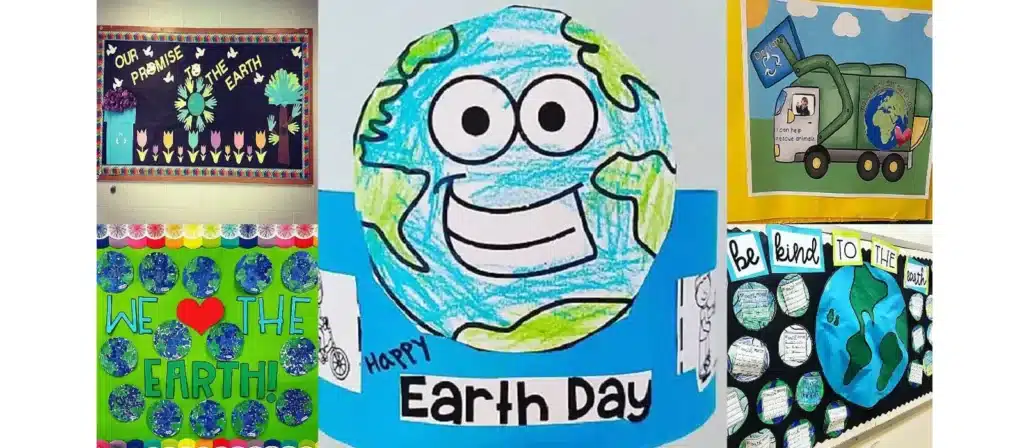
The Earth Day theme teaches environmental responsibility and introduces children to eco-friendly habits in developmentally appropriate ways. It encourages children to think about their role in the world and the impact of their actions on nature. This theme is not just for April — it fits beautifully into any season and aligns especially well with Montessori or Reggio-inspired classrooms.
Materials in the classroom may include books about trees, animals, and recycling; natural objects like leaves, rocks, and twigs; and sorting bins for plastic, paper, and compost. Children are encouraged to reuse materials in their art projects and to care for class plants or a small garden.
Key Learning Areas
- Environmental stewardship and cause-effect relationships
- Sorting and classification skills
- Responsibility and real-world problem solving
- Mindfulness and appreciation for nature
Extended Activities
- Set up a recycled art center with bottle caps, boxes, and old magazines
- Take nature walks to collect leaves, flowers, and rocks for observation
- Create a compost bin and teach what goes in it
- Hold a class “clean-up day” to pick up trash around the school yard
4. Fire Safety Preschool Classroom Themes
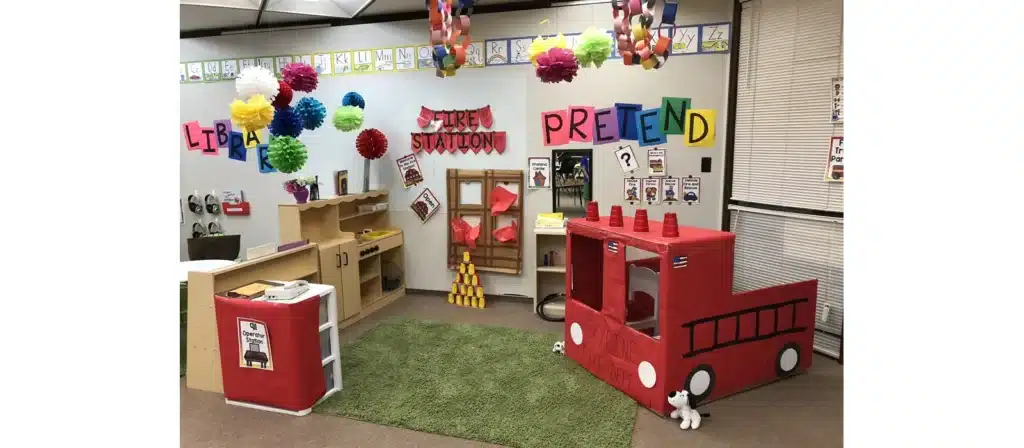
The Fire Safety theme equips children with essential knowledge that can save lives. Rather than instilling fear, this theme empowers children by showing them what to do in an emergency, and who their community helpers are. It also offers rich opportunities for role-play, storytelling, and physical movement.
The classroom may include a fire station dramatic play area, emergency symbol posters, firefighter-themed storybooks, and simple emergency drills. Children learn what firefighters wear and use, how to identify a smoke detector sound, and where to go during a fire drill.
Key Learning Areas
- Emergency preparedness and confidence building
- Listening and direction-following
- Community awareness (firefighters as helpers)
- Emotional regulation in unfamiliar situations
Extended Activities
- Practice “Stop, Drop, and Roll” with a parachute or yoga mat
- Set up a pretend fire truck with cardboard boxes and steering wheels
- Create emergency role-play kits with toy phones and walkie-talkies
- Read Firefighters A to Z or Clifford the Firehouse Dog as part of literacy integration
5. Music and Movement Preschool Classroom Themes

The Music and Movement theme brings joy, expression, and energy into your classroom. It builds gross motor coordination, rhythm, and listening skills — all while encouraging creativity and community participation. This theme appeals especially to children who learn through movement and sound.
Classroom zones may include instrument shelves, ribbon dancing spaces, and listening centers with headphones. Movement games like freeze dance, follow-the-beat, or instrument echo games help reinforce patterning and auditory processing. Music is also a great tool for transitions, emotional regulation, and classroom management.
Key Learning Areas
- Gross and fine motor skill development
- Auditory discrimination and rhythm recognition
- Emotional expression through movement
- Group cooperation and social-emotional bonding
Extended Activities
- Use homemade instruments (rice shakers, coffee can drums) for rhythm circles
- Dance to multicultural music to explore global rhythms
- Introduce yoga or stretching routines for calming movement
- Sing call-and-response songs to build early literacy and memory
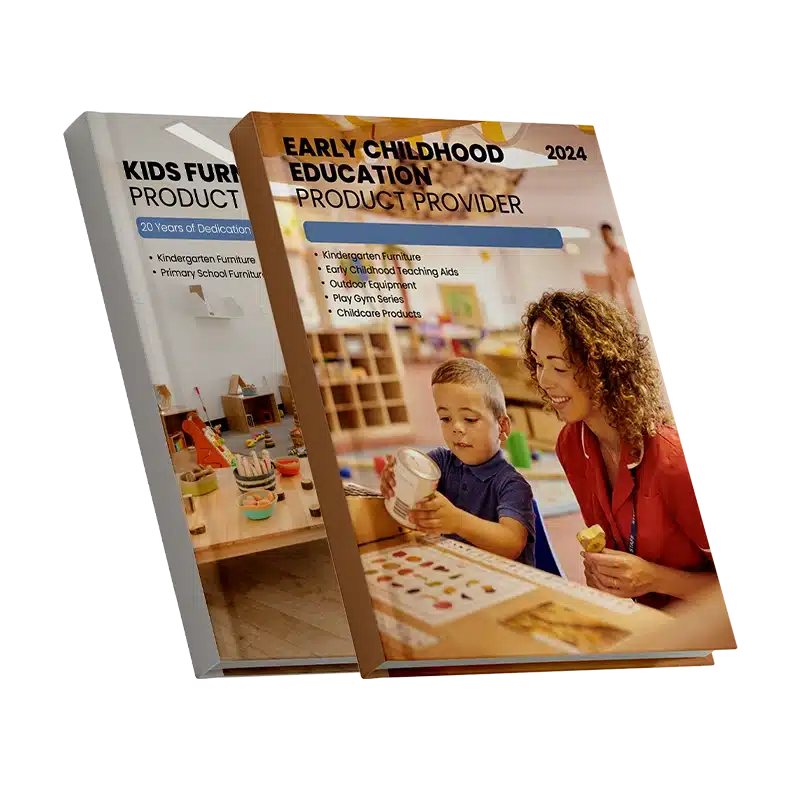
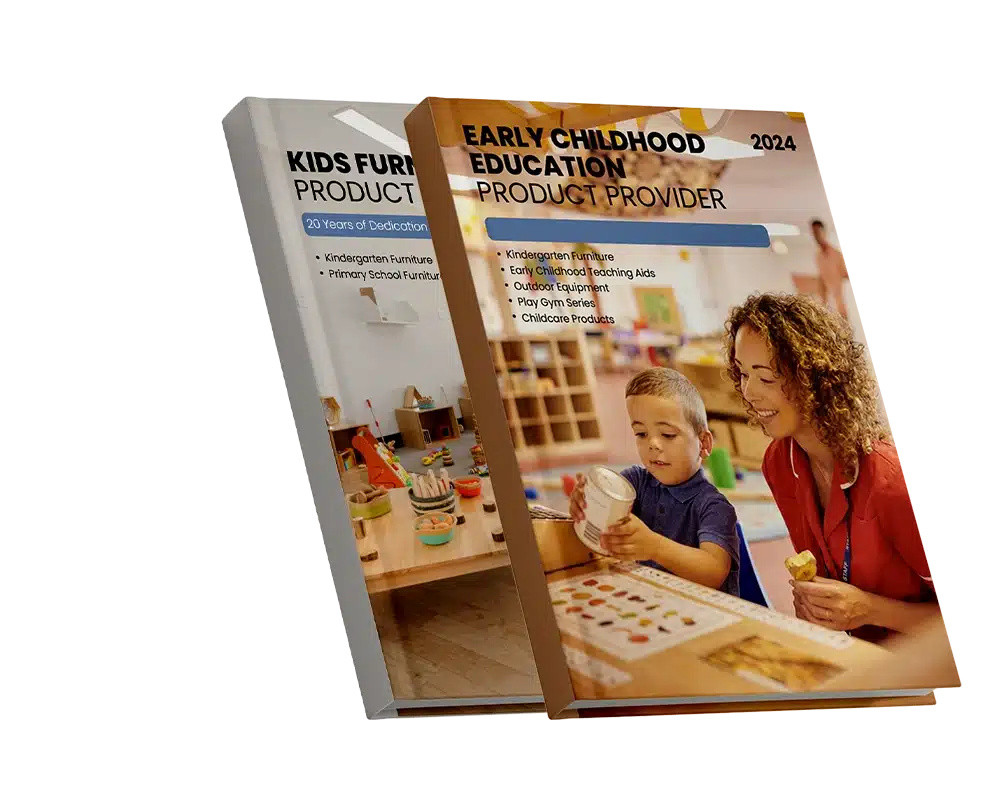
6. Camping Preschool Classroom Themes
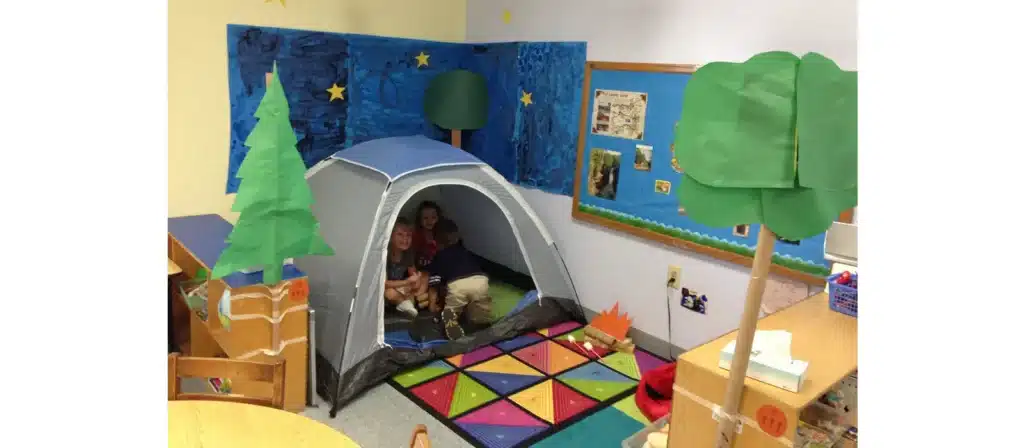
The Camping theme brings the joy and curiosity of outdoor adventures into the classroom. Children engage in role-play that mirrors real-life camping experiences — setting up tents, pretending to cook over a fire, observing animals, and stargazing. This theme provides a rich foundation for discussions about nature, survival, safety, and cooperation. It encourages both active and imaginative play, making it especially effective in indoor-outdoor learning environments.
The classroom setup may include a pretend campfire made from felt and logs, tents or blankets for shelter, lanterns, and “trail mix” math activities. Picture books about camping or forest animals enhance literacy connections. Teachers may even simulate a “night at camp” by dimming lights and playing forest sounds in the background.
Key Learning Areas
- Dramatic play and storytelling
- Nature-based vocabulary and science discovery
- Teamwork, sharing, and problem-solving
- Spatial awareness and sensory play
Extended Activities
- Set up a mini campsite with tents, flashlights, and sleeping bags
- Create trail maps and let children “hike” around the classroom
- Introduce leaf rubbing or pinecone painting as a creative art extension
- Make classroom “binoculars” with toilet paper rolls and go on animal-spotting walks
7. Jungle Preschool Classroom Themes
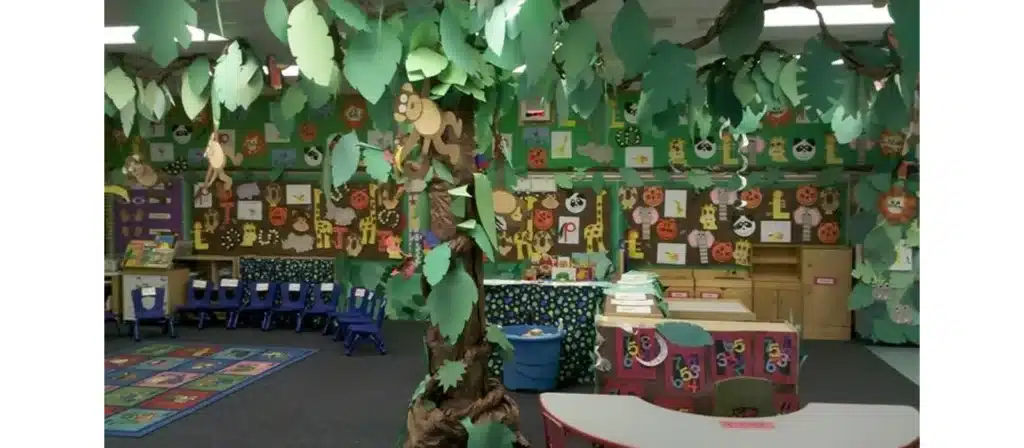
A Jungle theme immerses children in a wild, lush world full of sounds, animals, textures, and colors. It taps into a child’s natural fascination with exotic animals and mysterious environments. This theme is an excellent way to introduce new vocabulary, global geography, and sensory-based learning through role-play and science.
Teachers can set up jungle vines made from green paper, rainforest sounds playing softly in the background, and small-world animal figurines in sensory bins. Books such as Rumble in the Jungle or Giraffes Can’t Dance add depth to literacy centers. This theme also supports early classification and introduces concepts such as predator/prey or nocturnal/diurnal.
Key Learning Areas
- Animal science and life classification
- Sound, texture, and color sensory exploration
- Geography and habitat awareness
- Rhythmic language and poetic storytelling
Extended Activities
- Build a “jungle trail” obstacle course with logs, leaves, and ropes
- Use animal masks for a storytelling circle where each child plays a role
- Explore jungle drumming and movement as part of music integration
- Match animal footprints to the correct jungle animal in a tracking game
8. Farmhouse Preschool Classroom Themes
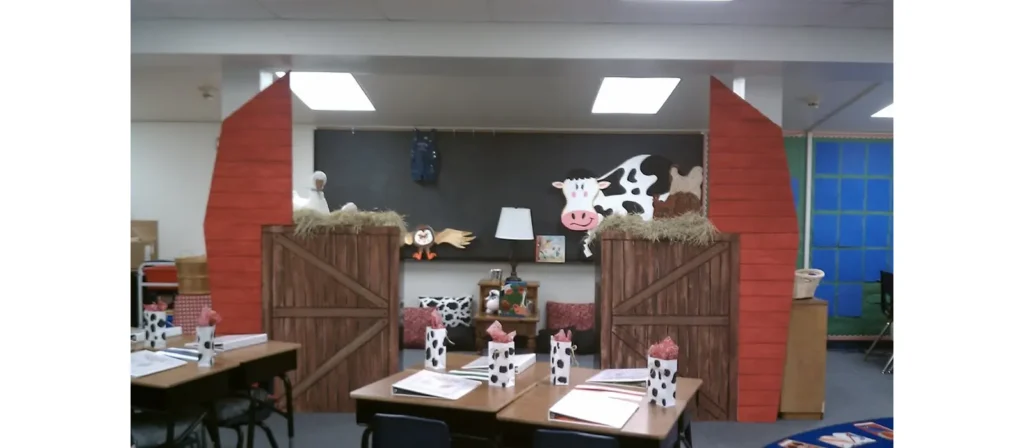
The Farmhouse theme connects children to rural life, food systems, and animals in a tangible, hands-on way. It’s especially valuable in urban preschools, where children may not have direct exposure to farming or animal care. This theme teaches responsibility, sequencing (how food grows), and the importance of daily routines.
Classroom centers may include a dramatic play farmer’s market, a mini garden bed, and realistic toy animals with labeled pens. Books like Big Red Barn and Click Clack Moo create connections between literacy and farm life. This theme also fits seamlessly with math (egg counting), science (life cycles), and practical life activities (watering plants, “feeding” animals).
Key Learning Areas
- Practical life skills and responsibility
- Understanding food origins and seasonal cycles
- Classification and vocabulary development (animals, tools, crops)
- Sequencing and storytelling
Extended Activities
- Plant fast-growing vegetables like radishes or lettuce for observation
- Create a classroom chore chart with “farm jobs” for each student
- Sort toy animals by type or habitat (farm vs. wild)
- Sing farm songs during transitions or group gatherings (Old MacDonald, Baa Baa Black Sheep)
9. Space Preschool Classroom Themes
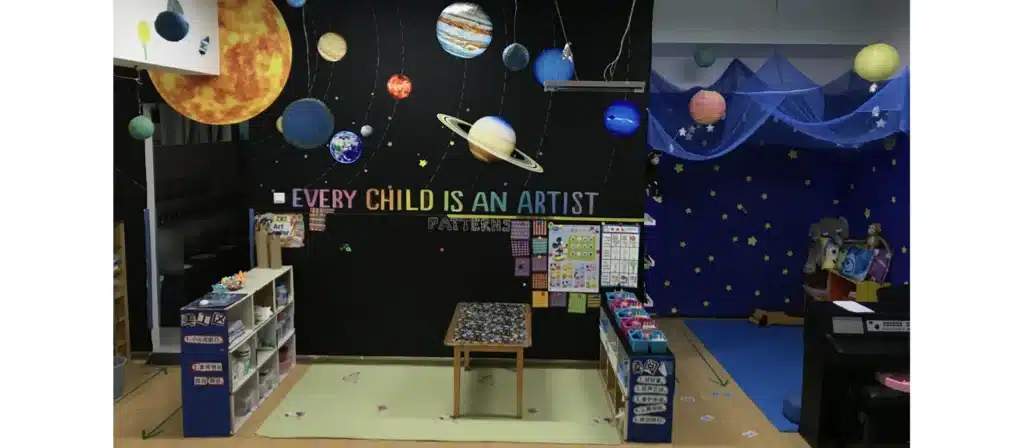
The Space theme transports children to the galaxy beyond — introducing them to planets, stars, astronauts, and rockets. It sparks imagination while also offering rich science connections, including observation, categorization, and abstract thinking. It’s particularly engaging for children fascinated by the unknown and filled with opportunities to combine STEM learning with creative exploration.
The classroom can be transformed with starry ceilings, glow-in-the-dark planets, and space-themed sensory bins. Teachers might introduce space-themed vocabulary like “orbit,” “gravity,” and “meteor.” Children can pretend to be astronauts, build rocket ships from cardboard, or explore moon sand with tools and molds.
Key Learning Areas
- Scientific inquiry and abstract reasoning
- Spatial vocabulary and STEM foundations
- Creative engineering and dramatic role-play
- Number sequencing and size comparison (e.g., planets by size)
Extended Activities
- Build model rockets from recycled materials
- Create a “moon walk” using pillows and textured flooring for sensory input
- Match planets to their names and colors in a circle time game
- Play freeze dance with “space sounds” for movement and rhythm awareness
10. Donut Preschool Classroom Themes
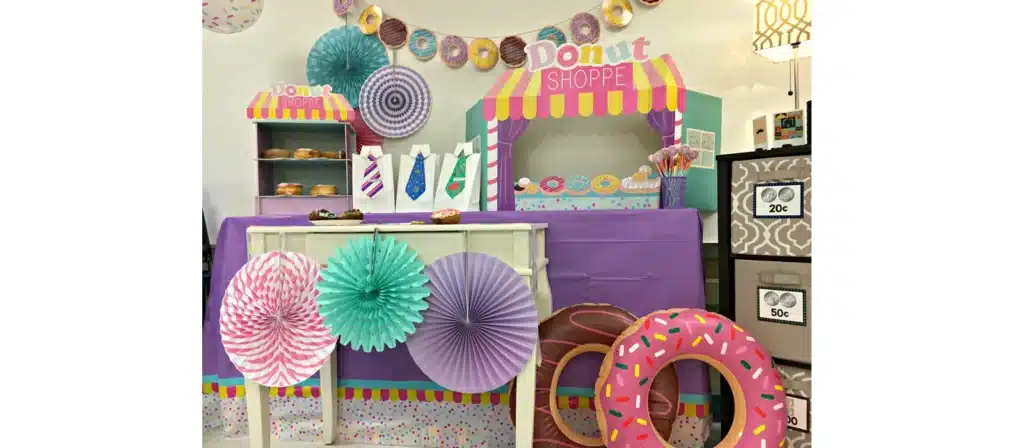
Though simple and sweet, the Donut theme is a playful entry point for exploring math, patterns, colors, and sensory play. This theme creates high engagement levels due to its familiarity and fun aesthetic. It also offers cross-curricular integration with sorting, shape recognition, and pretend play.
The classroom might include a pretend donut shop, felt or cardboard donut crafts, and real ingredient sensory bins (like flour or sprinkles). Children can decorate paper donuts, design their own flavors, or “sell” them to peers using pretend currency.
Key Learning Areas
- Shape, color, and pattern recognition
- Imaginative storytelling and customer role-play
- Counting, sorting, and early math operations
- Tactile exploration and fine motor control
Extended Activities
- Host a classroom “Donut Shop Day” with apron dress-up and pretend menus
- Create donut-themed pattern cards using colors or sprinkles
- Roll playdough into donut shapes and decorate with beads or seeds
- Count how many donuts each “customer” buys and track with tallies


11. Sports Preschool Classroom Themes
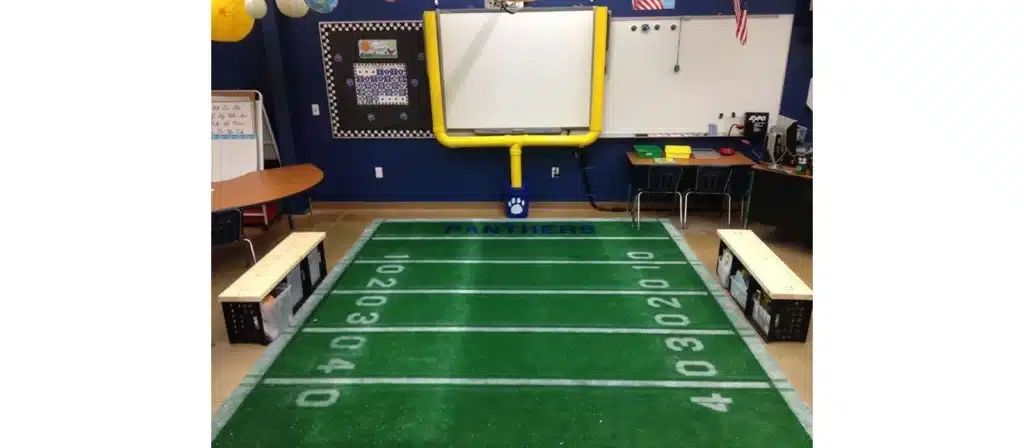
The Sports theme brings energy, collaboration, and healthy movement into the classroom. It teaches children the importance of physical activity, teamwork, and resilience — all through fun, age-appropriate games and role-play. This theme is especially effective for developing gross motor skills and promoting positive social interactions.
Classroom environments can feature stations for different sports like soccer, basketball, or track-style races. Props such as cones, jerseys, mini-goals, and plastic balls allow for structured and unstructured play. Books about sportsmanship and short videos of athletes in action help children understand values like fairness, practice, and perseverance.
Key Learning Areas
- Gross motor development through active play
- Social-emotional learning via teamwork and turn-taking
- Health and fitness awareness
- Spatial reasoning and body coordination
Extended Activities
- Set up a mini “Olympics” with stations for jumping, throwing, and balance
- Host a pretend sports day with role-play announcers and players
- Chart classroom sports participation on a graph to introduce early data skills
12. Beach Preschool Classroom Themes
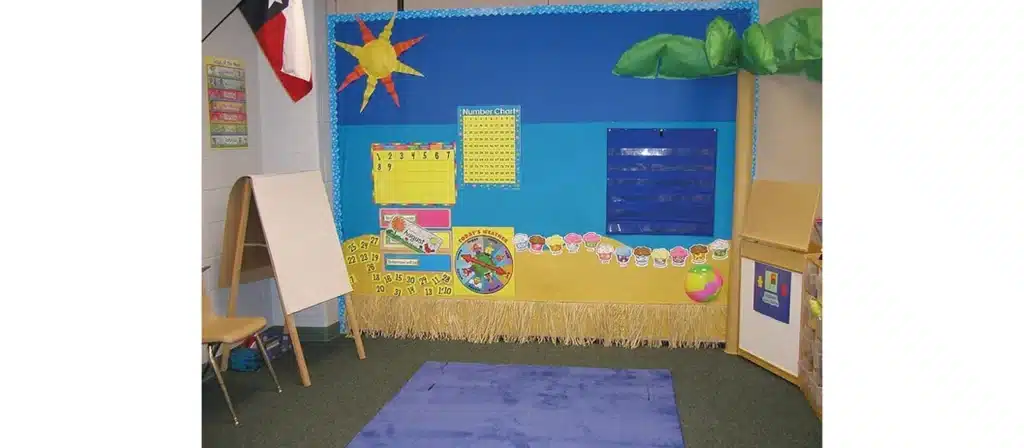
The Beach theme is perfect for sensory exploration, seasonal celebration, and imaginative play. Whether your preschool is near a real beach or far from the coast, this theme brings in the sun, sand, and sea through hands-on, multisensory learning. Children explore shells, waves, marine life, and the joys of a day “by the water.”
Your classroom may include a sandy sensory bin with shovels and molds, beach umbrellas, towels, and inflatable animals. Blue fabrics can represent the ocean in dramatic play, while ocean-themed books and songs round out the experience. It’s also a great theme to connect with environmental awareness and sea creature studies.
Key Learning Areas
- Sensory development through texture and temperature
- Imaginative storytelling and role-play
- Early science understanding of habitats and marine life
- Vocabulary building around beach-related items and actions
Extended Activities
- Create “beach in a bag” sensory kits with sand, shells, and small toys
- Sing songs like Baby Beluga or Down By the Bay
- Conduct a “clean the beach” sorting activity with pretend trash
- Use shells and stones for simple counting and sorting games
13. Superhero Preschool Classroom Themes
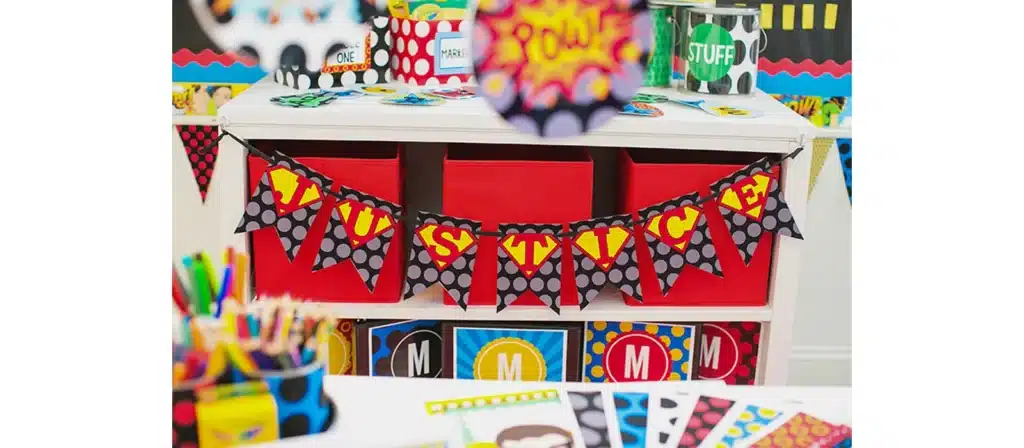
The Superhero theme empowers children by allowing them to imagine themselves as brave, helpful, and strong individuals who can make a difference. This theme is not about fictional powers alone — it encourages children to recognize real-life traits like kindness, courage, and teamwork. It’s an excellent way to teach social-emotional skills, problem-solving, and self-confidence.
In the classroom, a superhero theme might include capes and masks for dramatic play, “mission cards” that involve helping others, or posters showing classroom rules as heroic actions (e.g., “Superheroes take turns!”). Children can even create their own superhero personas, complete with a unique power that reflects their personal strengths.
Key Learning Areas
- Emotional intelligence and self-regulation
- Cooperative play and social-emotional development
- Identity formation and self-expression
- Problem-solving and critical thinking
Extended Activities
- Create superhero ID cards where each child draws their costume and names a personal strength
- Use obstacle courses as “super training” to support gross motor development
- Act out classroom scenarios where superheroes solve problems (e.g., helping a sad friend)
14. Rainbow Preschool Classroom Themes
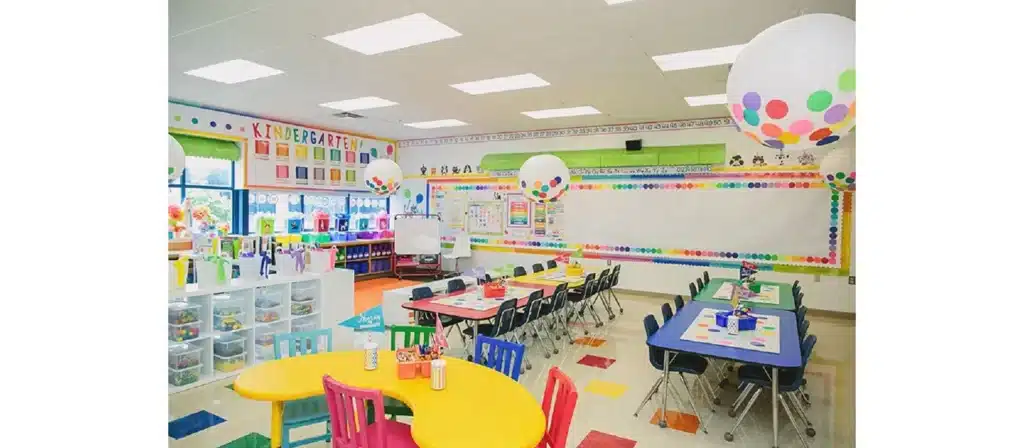
The Rainbow theme is visually stimulating and full of opportunities for learning across disciplines — from color theory and classification to emotional expression and weather patterns. It’s an ideal theme for young learners, especially when integrated into art, sensory play, and early science exploration.
Classroom decor may include hanging rainbow streamers, color-themed shelves, or a weather station with rainbows and clouds. Children explore colors by mixing paints, sorting colorful objects, and learning the color order through songs and movement.
Key Learning Areas
- Color recognition and sequencing
- Pattern building and visual memory
- Emotional expression through color symbolism
- Weather and natural phenomenon understanding
Extended Activities
- Create a large collaborative rainbow mural with finger painting
- Mix primary colors in ziplock bags to watch new colors form
- Conduct light experiments with prisms or clear cups of water
- Play “Color Scavenger Hunt” — children find objects around the room for each rainbow color
15. Garden Preschool Classroom Themes
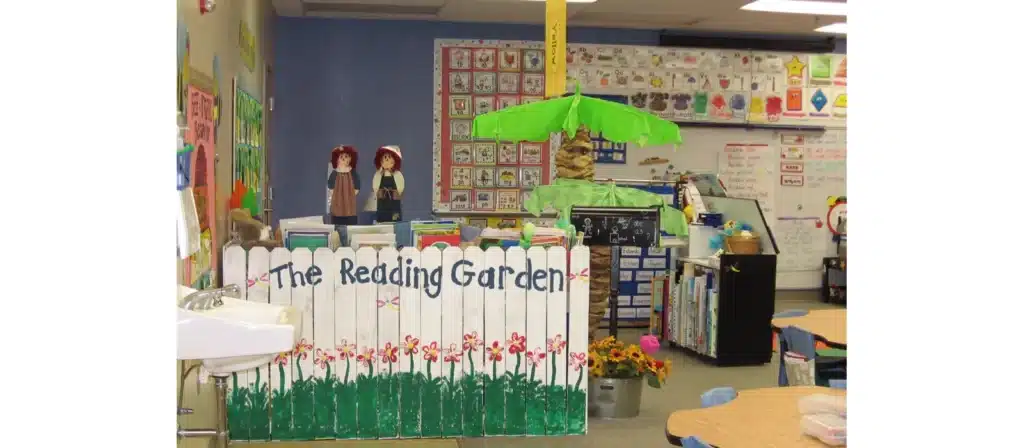
A Garden theme helps children explore the life cycle of plants, the importance of nurturing living things, and the interconnectedness of nature. This theme naturally supports science, environmental literacy, fine motor development, and responsibility. It aligns closely with Montessori values by offering real, hands-on work with soil, seeds, and tools.
The classroom can feature a mini greenhouse, planting station, flower classification charts, and watering routines. Children learn how seeds grow, what plants need, and how to take care of living organisms with respect.
Key Learning Areas
- Life sciences and biology fundamentals
- Responsibility and care for living systems
- Fine motor control through planting and watering
- Sensory exploration through soil, textures, and scents
Extended Activities
- Grow fast-germinating seeds (e.g., beans, grass) in clear cups for observation
- Sort seeds by shape and size for a tactile math activity
- Label plant parts using craft materials (e.g., stem, roots, leaves)
- Use nature journals to document plant changes over time


16. Mathematics Preschool Classroom Themes
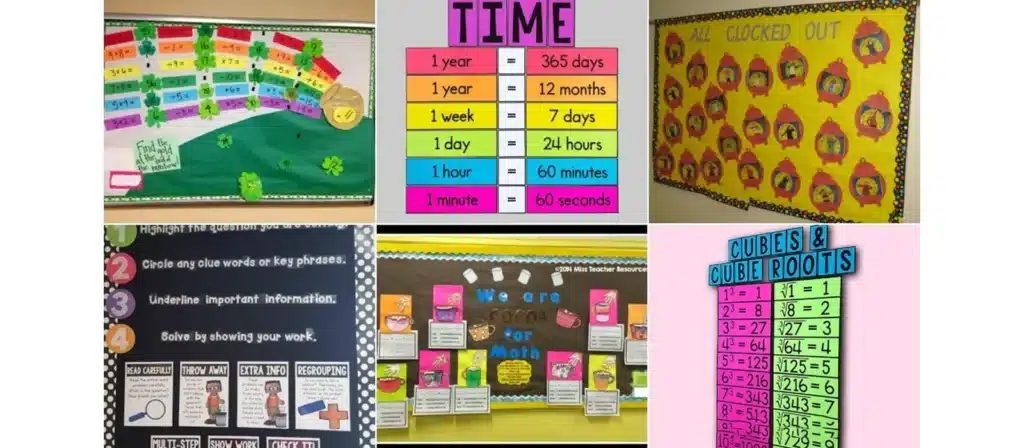
The Mathematics theme introduces basic numeracy skills in an inviting, hands-on manner. With a thematic focus on math, children learn to explore counting, sorting, patterns, shapes, and measurement in fun and meaningful ways. This theme is not just about numbers — it’s about building a foundation for logic, reasoning, and problem-solving.
Your classroom may include a math center with manipulatives such as counting bears, pattern blocks, bead strings, and measurement tools. Books, songs, and games are also essential to reinforce concepts such as more/less, same/different, and number recognition.
Key Learning Areas
- Number sense and basic arithmetic
- Spatial awareness and geometry
- Pattern recognition and sequencing
- Logical thinking and classification
Extended Activities
- Create number-themed scavenger hunts around the classroom or playground
- Use real objects like snack items to teach sorting, adding, and subtracting
- Build shape puzzles and match objects to outlines
- Sing math-based songs such as Five Little Ducks or One, Two, Buckle My Shoe
17. Dinosaur Paradise Preschool Classroom Themes
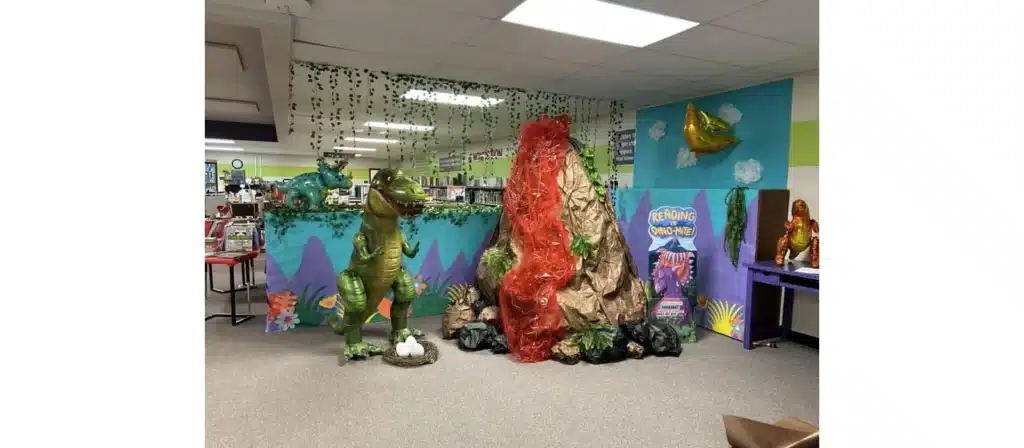
Dinosaurs are a perennial favorite with young children, offering a gateway to history, paleontology, and rich imaginative play. The Dinosaur Paradise theme creates an environment where children can explore big ideas — extinction, evolution, time, and natural history — in a way that’s exciting and approachable.
The classroom might feature a fossil dig site with brushes and sand, dramatic play areas with dinosaur costumes, and books like How Do Dinosaurs Say Goodnight?. Realistic models of different species help children learn about herbivores, carnivores, and physical adaptations like claws or tails.
Key Learning Areas
- Classification and comparison (size, diet, features)
- Time concepts (past, present) and historical thinking
- Vocabulary and language development
- Problem-solving through excavation and reconstruction play
Extended Activities
- Set up a “dino dig” with buried bones and small shovels
- Create a volcano eruption experiment using baking soda and vinegar
- Match dinosaur footprints to species in a movement-based game
- Make salt dough fossils and let them dry overnight for take-home keepsakes
18. Magical Forest Preschool Classroom Themes
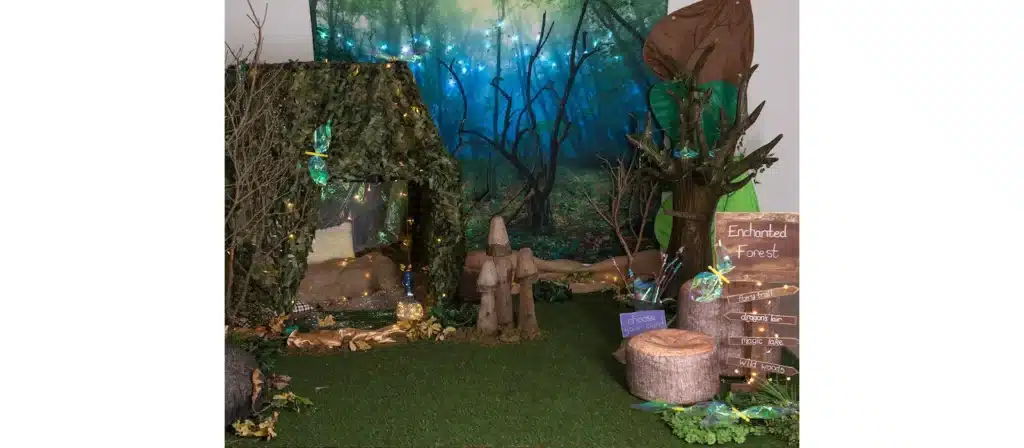
The Magical Forest theme blends nature with imagination — creating an enchanted space where fairies, woodland creatures, and natural wonders come to life. This theme supports storytelling, sensory engagement, and emotional connection to the outdoors. It also promotes calm, focus, and exploration.
Classroom setups may include soft lighting, leaf garlands, mossy textures, and nature-inspired loose parts. Children can create their own forest creature characters, build fairy houses from natural materials, and listen to woodland soundscapes. This theme also encourages mindfulness through quiet observation of nature.
Key Learning Areas
- Creative storytelling and character development
- Emotional regulation through calm play environments
- Sensory integration with natural textures and sounds
- Imaginative role-play and symbolic thinking
Extended Activities
- Build a fairy village with twigs, bark, and stones
- Create forest animal puppets for storytelling circles
- Use nature journals to document “magical” forest finds
19. Culinary Adventure Preschool Classroom Themes
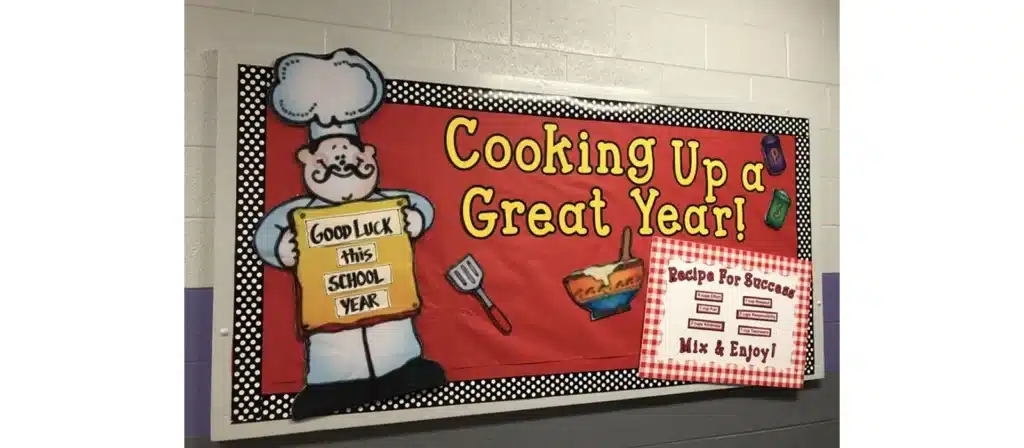
The Culinary Adventure theme introduces children to food preparation, nutrition, and cultural diversity. Through sensory play and real-life experiences, children develop fine motor skills, independence, and an appreciation for different cuisines. This theme also encourages responsibility and hygiene through handwashing routines and kitchen safety practices.
Your classroom might include a pretend kitchen, real cooking tools (under supervision), and food-related picture books. Children can explore textures and tastes, practice measuring and mixing, and participate in food preparation activities like making fruit salad or baking bread.
Key Learning Areas
- Practical life skills and fine motor coordination
- Early math through measuring and portioning
- Cultural awareness and food diversity
- Vocabulary development related to cooking and ingredients
Extended Activities
- Host a “tasting day” featuring fruits or snacks from different countries
- Create recipe cards with drawings and simple instructions
- Let children “shop” for ingredients using pretend money and labeled bins
- Bake together and document the process through drawings and dictation
20. Art Studio Preschool Classroom Themes
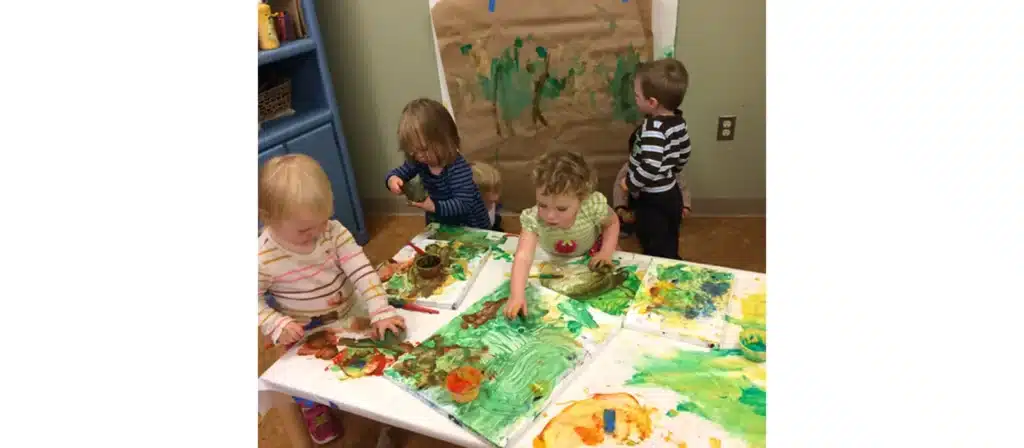
The Art Studio theme transforms your classroom into a space of free expression, experimentation, and process-focused creation. It encourages children to explore color, texture, form, and media — without worrying about the end product. This theme is ideal for fostering confidence, decision-making, and fine motor development.
The classroom environment may feature easels, open shelves with art supplies, color mixing stations, and rotating provocations (like clay, charcoal, or recycled materials). The focus is on open-ended exploration and providing real tools — not just pre-cut crafts.
Key Learning Areas
- Fine motor skill refinement
- Visual arts appreciation and vocabulary
- Emotional expression through abstract representation
- Independence and choice-making
Extended Activities
- Set up an “artist of the week” display with famous works and child-led interpretations
- Offer collaborative mural projects with large-scale paper
- Explore printmaking with leaves, sponges, or textured surfaces
- Host a gallery walk where children present their creations to peers


21. Around the World Explorers Preschool Classroom Themes
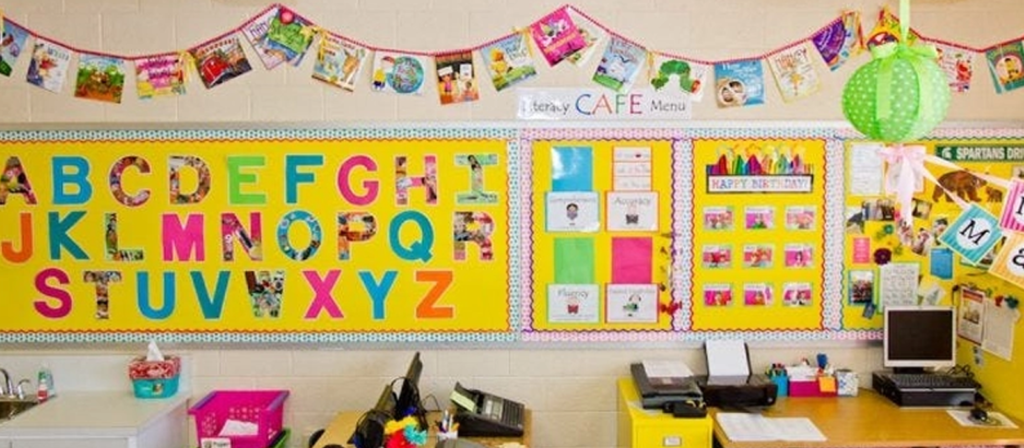
The Around the World Explorers theme introduces children to global cultures, languages, traditions, and geography. It encourages curiosity, respect for diversity, and a broadened worldview — even in early childhood. This theme works especially well in internationally diverse classrooms or bilingual programs, as it provides a context for cultural inclusion and celebration.
The classroom may be organized into “country stations,” with each area highlighting a different culture. Artifacts, flags, traditional clothing, maps, instruments, and food models can all be used to spark discussion and interactive exploration. Storytime becomes a journey across the globe with folktales and songs from different countries.
Key Learning Areas
- Cultural awareness and empathy
- World geography and map skills
- Language exposure and vocabulary expansion
- Social studies and global traditions
Extended Activities
- Create passport booklets where children collect “stamps” after each country activity
- Cook or pretend-play with foods from various regions
- Learn greetings in different languages and match to flags
- Use a globe or large map to follow the “travel path” of the week
22. Weather Wonders Preschool Classroom Themes
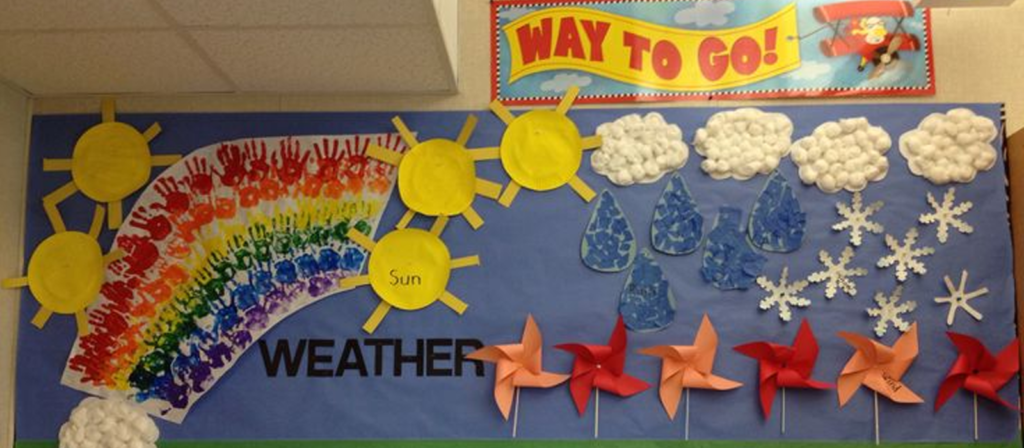
The Weather Wonders theme is a hands-on way to introduce children to science through daily observation and seasonal changes. Children learn to identify weather patterns, track daily conditions, and understand how weather affects the natural world and human life.
Classroom elements may include a weather chart, thermometer, rain gauge, cloud classification posters, and sensory bins for rain, snow, or sunshine. Songs, poems, and movement games support deeper understanding of abstract concepts like wind or evaporation.
Key Learning Areas
- Scientific observation and recording
- Vocabulary related to weather and seasons
- Cause-and-effect thinking
- Sensory exploration and pattern recognition
Extended Activities
- Make a daily weather report board that children update each morning
- Use cotton balls, water spray, and ice cubes to explore different forms of precipitation
- Create a class weather book by illustrating favorite weather days
- Dress paper dolls in weather-appropriate clothing to reinforce decision-making
23. Transportation Station Preschool Classroom Themes
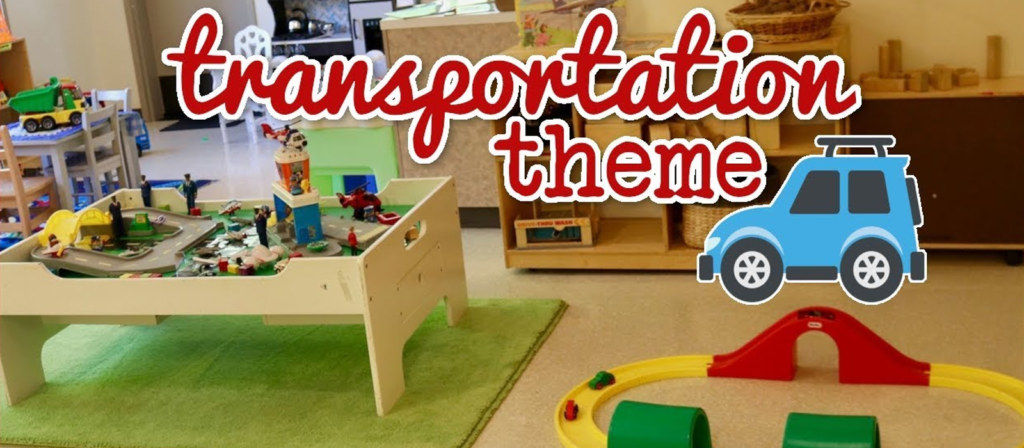
The Transportation Station theme teaches children about vehicles, movement, and how people travel from place to place. It supports concepts of motion, direction, safety, and community awareness. This theme is also ideal for building classification and sorting skills.
Classrooms may be organized into “modes of transport” zones — land, air, sea — using toy vehicles, tracks, maps, and posters. Teachers can integrate transportation vocabulary, directional terms (left, right, stop, go), and safety routines like crossing the street.
Key Learning Areas
- Classification and categorization
- Spatial awareness and directional language
- Community roles (drivers, pilots, conductors)
- Gross motor development through movement play
Extended Activities
- Set up a cardboard “bus” or “train” for dramatic play
- Create a transportation graph based on how children travel to school
- Play movement games like “Red Light, Green Light” or “Drive the Bus”
- Read books like The Little Engine That Could or Don’t Let the Pigeon Drive the Bus
24. Underwater Adventure Preschool Classroom Themes
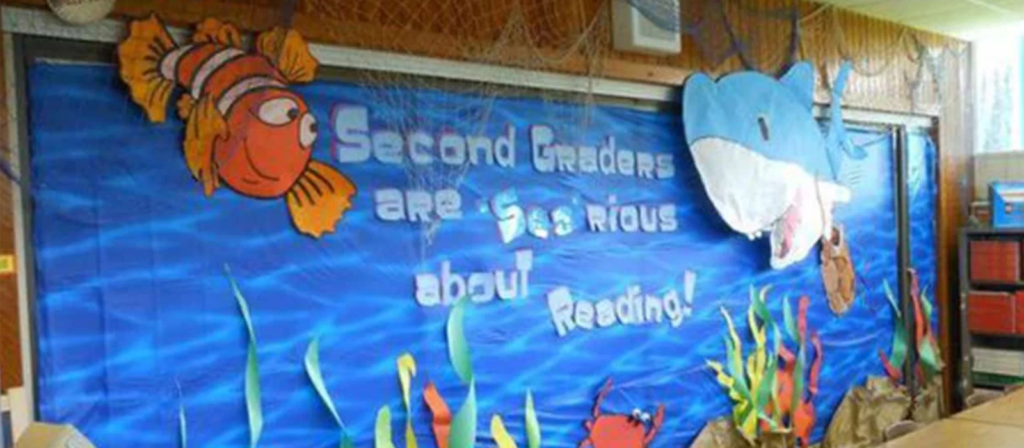
The Underwater Adventure theme immerses children in the wonders of marine life and ocean ecosystems. It fosters respect for aquatic animals and helps children understand habitat diversity. This theme can also incorporate environmental awareness, like protecting oceans from pollution.
Classroom setups may include blue fabrics for water, sensory bins with sea animals and shells, and books about ocean life. Children can create coral reefs using recycled materials, learn about ocean layers, and play with floating/sinking experiments.
Key Learning Areas
- Marine biology and life cycles
- Sensory exploration of texture and movement
- Vocabulary around ocean animals and habitats
- Environmental responsibility
Extended Activities
- Sort sea creatures by color, size, or habitat (reef, deep sea)
- Paint ocean murals with different sea levels (surface, mid-water, floor)
- Make jellyfish from paper plates and streamers
- Conduct sink/float tests with classroom materials in a water bin
25. Construction Zone Preschool Classroom Themes
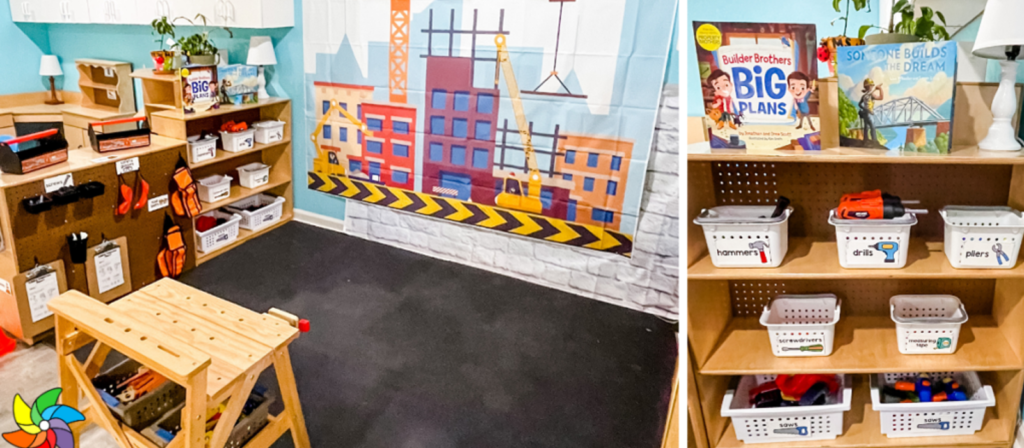
The Construction Zone theme encourages problem-solving, collaboration, and physical development. It’s perfect for children who love to build, explore tools, and engage in open-ended projects. This theme blends STEM learning with dramatic play and motor skill development.
Set up areas with building blocks, foam bricks, plastic tools, blueprints, and hard hats. Incorporate real-world math with measuring tapes and counting screws or blocks. Children love acting as architects, engineers, and builders, all while strengthening spatial reasoning.
Key Learning Areas
- Engineering concepts and structural design
- Fine and gross motor coordination
- Teamwork and collaboration
- Shape, size, and measurement vocabulary
Extended Activities
- Build towers or bridges and test their stability
- Create building blueprints using grid paper
- Label parts of a tool and discuss safety procedures
- Invite a real builder or architect to do a class Q&A


26. Time Travelers Preschool Classroom Themes
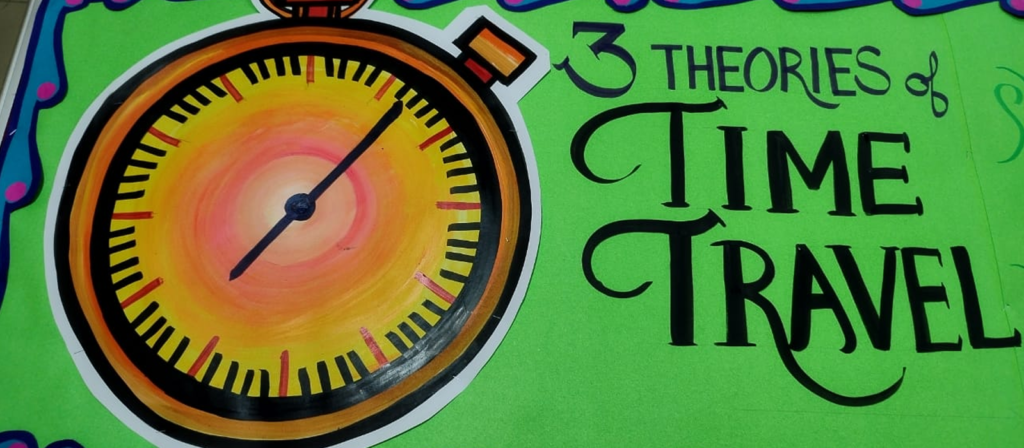
The Time Travelers theme takes children on imaginary journeys to different eras — from ancient civilizations to the future. It introduces concepts of history, timelines, and cultural change in a playful, narrative-driven way. This theme supports storytelling, dress-up, and critical thinking.
Divide the classroom into different “eras” — prehistoric, medieval, space future — with artifacts, costumes, and age-appropriate stories. Children explore how people lived, dressed, communicated, and played in different periods of time.
Key Learning Areas
- Time awareness and sequencing
- Cultural understanding and imagination
- Narrative skills and expressive language
- History and innovation introduction
Extended Activities
- Make a “timeline wall” showing past, present, future with visuals
- Host a “dress like a time traveler” day
- Create ancient tools or futuristic gadgets from recycled materials
- Tell group stories where each child adds a “chapter” in a new time period
27. Kindness Kingdom Preschool Classroom Themes
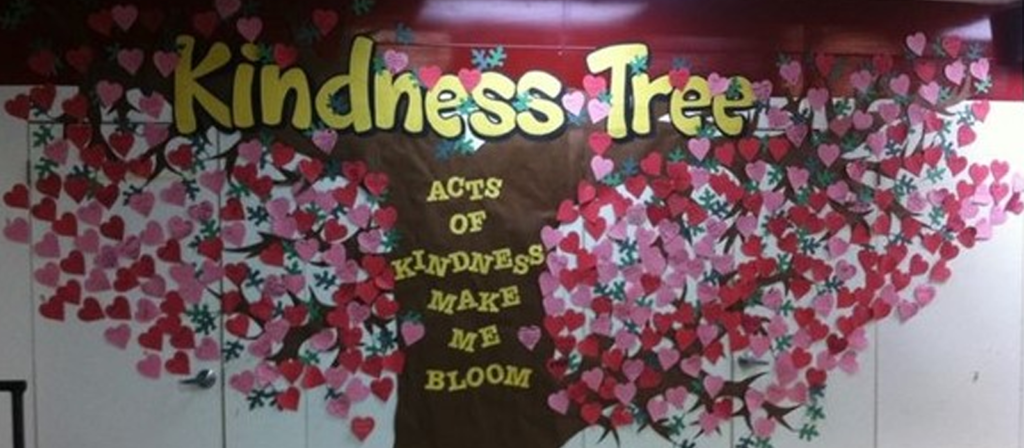
The Kindness Kingdom theme centers on emotional intelligence, empathy, and social responsibility. It encourages children to be community-minded, inclusive, and thoughtful through role-play, storytelling, and collaborative art.
Classrooms can feature a “kindness wall,” feelings charts, friendship centers, and puppets for social scenarios. Teachers use books, songs, and group reflections to promote concepts like helping others, resolving conflicts, and celebrating diversity.
Key Learning Areas
- Social-emotional development
- Empathy and perspective-taking
- Conflict resolution and sharing
- Community building and cooperation
Extended Activities
- Give children kindness “missions” like helping a friend or sharing supplies
- Create friendship bracelets or art gifts for classmates
- Read books like Have You Filled a Bucket Today?
- Role-play common preschool social scenarios with puppets
28. Pet Care Preschool Classroom Themes
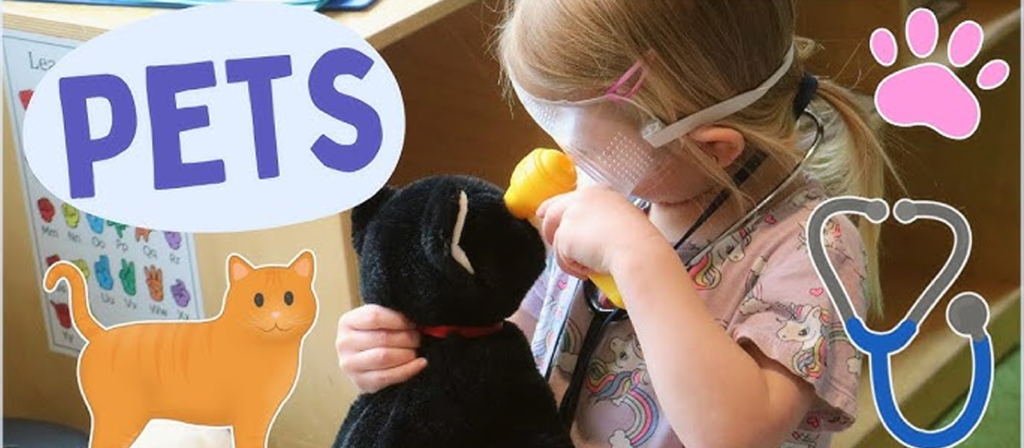
The Pet Care theme teaches responsibility, empathy, and biology by focusing on how to care for animals. It gives children insight into daily routines, needs, and respectful handling of pets — real or pretend.
Your classroom may include a dramatic play veterinary clinic, grooming station, and stuffed animals for role-play. Children can learn about different animal species, how to feed and clean them, and what it means to be a good pet owner.
Key Learning Areas
- Responsibility and caregiving
- Animal science and classification
- Emotional connection and empathy
- Sequencing routines and schedules
Extended Activities
- Set up a pretend vet office with clipboards, bandages, and thermometers
- Create pet “care charts” to track feeding, grooming, and exercise
- Invite a classroom pet (hamster, fish) or virtual visit with a pet expert
- Sort toy animals by domestic vs. wild
29. Eco Explorers Preschool Classroom Themes
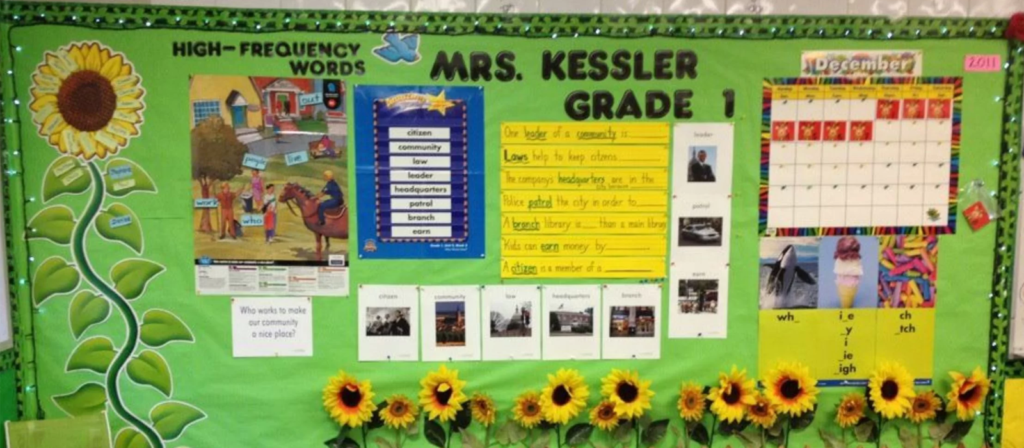
Eco Explorers is a nature-based theme that helps children develop environmental awareness through active exploration and stewardship. It’s ideal for outdoor classrooms or nature-rich Montessori/Reggio settings.
Set up stations for nature walks, composting, recycling, and outdoor observation. Use magnifying glasses, buckets, and journals for recording findings. Children learn about ecosystems, conservation, and the joy of being outside.
Key Learning Areas
- Nature literacy and earth science
- Responsibility and sustainability
- Observation and documentation
- Cause-effect thinking in natural systems
Extended Activities
- Create nature journals to sketch leaves, bugs, and trees
- Sort classroom waste into bins and explain recycling categories
- Build bug hotels or bird feeders using natural materials
- Conduct a “clean-up day” for your school yard or nearby park
30. Shapes and Structures Preschool Classroom Themes

The Shapes and Structures theme blends geometry with building and design. Children explore basic shapes, how they combine to make structures, and how forms affect strength and balance. It supports foundational STEM skills and critical thinking.
Classroom materials might include wooden blocks, 3D shape sorters, cardboard architecture kits, and tangrams. Teachers can introduce real-world architecture through books and photos, prompting discussions about houses, bridges, and towers.
Key Learning Areas
- Spatial reasoning and geometry
- Engineering and design skills
- Math vocabulary (sides, corners, symmetry)
- Creative problem-solving
Extended Activities
- Build structures with specific shape rules (e.g., only triangles and squares)
- Go on a “shape hunt” around the classroom or playground
- Use clay or sticks to build 2D and 3D models
- Explore famous structures (Eiffel Tower, pyramids) and create classroom replicas


How Can You Effectively Implement These Themes in Your Classroom?
Creating a theme-based classroom involves more than just decorating and integrating the themes into daily activities, lessons, and classroom materials. For instance, an ‘Under the Sea’ themes can include reading stories about sea creatures, science lessons on marine life, and art projects with ocean themes.
Furthermore, it’s important to consider the age group and interests of your students when selecting a themes. A preschool classroom themes that is too complex might not resonate with younger children, while something too simple might not engage older preschoolers.
How to Incorporate a Theme Into Daily Preschool Activities?
Incorporating a theme into daily preschool activities can transform routine learning into an exciting adventure. Start by integrating the classroom theme into various subject areas, ensuring that it is not limited to just one aspect of learning. For example, if your theme is dinosaurs, you can incorporate it into language arts by reading dinosaur-themed stories, math by counting dinosaur footprints, and science by exploring fossils. This helps preschoolers understand how different subjects can be connected through a single, engaging topic, making the learning experience more meaningful.
Make use of thematic centers in your classroom. Set up areas where children can engage in themed play, such as a “dinosaur dig” sandbox, a reading nook filled with books about prehistoric creatures, or an preschool furniture art station where they can create dinosaur crafts. These classroom theme sets encourage hands-on exploration and reinforce the overall theme. Creating themed play centers like this fosters imagination, creativity, and social interaction among preschoolers, making learning even more engaging. This type of thematic play also supports the development of fine motor skills and cognitive abilities as children actively participate in the process.
In addition to center activities, consider daily rituals and routines that align with your classroom theme ideas. For instance, during circle time, you can discuss a different aspect of the theme each day. If your theme is ocean life, one day could focus on jellyfish, another on coral reefs, etc. You create a cohesive learning environment where children feel immersed in the topic by introducing classroom decoration ideas that reflect your theme, such as ocean-inspired posters or themed songs.
Lastly, document the children’s learning journey by showcasing their progress through themed activities. Create a classroom display that highlights their work, including photos of activities, projects, and experiences related to the theme. This celebrates their achievements and reinforces their learning by visualizing what they’ve explored. Whether you’re showcasing preschool classroom themes decor with a space theme or a farm theme, these displays can help children reflect on their experiences and provide a sense of accomplishment.
Incorporating a preschool classroom themes holistically ensures that the theme is more than just classroom decoration. It becomes a dynamic tool that supports multiple aspects of a child’s development, creating a stimulating and immersive environment that enhances the learning experience.
Maintaining and Updating Your Preschool Classroom Themes
Keeping classroom topics fresh and engaging over time requires regular updating and adaptation. This maintains interest and adapts to changing educational goals and student needs.
Here are some tips to help you do just that:
- Rotate decorations:
Change decorations regularly to keep the themes visually interesting. Consider changing posters, banners, and wall displays to reflect different themes throughout the year. - Involve students in the process:
Involving students in selecting, implementing, and updating themes can foster a sense of ownership and engagement. This collaborative approach can also provide valuable insights into what topics resonate best in the classroom. - Assessment and Adaptation:
Regularly assess the extent to which the themes meet educational and engagement goals. Student feedback and observations of classroom dynamics can inform necessary adaptations or accomplish themes changes. - Seasonal Adaptation:
Incorporate seasonal elements into your themes to keep them relevant and appealing. For example, if your themes is “Farm Life,” you can introduce activities and decorations related to planting and harvesting in the spring and fall. - Stay inspired:
Constantly seeking new ideas and inspiration for topics prevents stagnation. Professional development, collaboration with colleagues, and research can provide new perspectives and innovative approaches to teaching topics.


The Role of Teachers in Implementing and Maintaining Preschool Classroom Themes
Teachers play a key role in bringing classroom topics to life and ensuring their success. Their enthusiasm, creativity and commitment can transform a simple idea into a powerful tool for learning and development.
- Planning and Preparation: Teachers are responsible for selecting themes, planning activities, and gathering resources to support the selected themes. This includes conducting research, developing lesson plans, and ensuring all materials are age-appropriate and aligned with the curriculum.
- Creativity and flexibility: Teacher creativity in designing and adapting themes can greatly enhance their appeal and educational value. Flexibility in responding to student responses and feedback is equally important in maintaining an engaging learning environment.
- Facilitation of learning: Teachers guide children through theme-related activities and experiences. They provide support, encouragement and opportunities for children to explore, inquire and make connections within the context of the themes.
- Assess progress: Teachers monitor and assess children’s progress, adapting activities and strategies to meet individual needs. They observe children’s participation, engagement, and understanding of the topic and adjust as needed.
Conclusion
Choosing the right themes for your preschool classroom is vital in creating an enriching environment for your students. By carefully selecting a theme that promotes learning, engagement, and creativity, you can give your students a foundation for success. Remember, the best themes inspire you and your students to explore and learn together.
For more details on preschool classroom themes, you can contact us and we can help you not only plan your classroom themes, but also help with classroom layout design!



